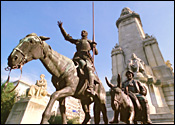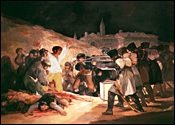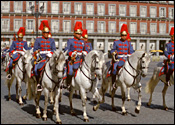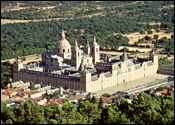


Travel Guide | Photo Gallery |
Airfare & Hotels
in Madrid |
Contact Us
| Home _
| __Spain Travel
Guide: Introduction |
For the
first-time visitor, the face of Spain can be compared to that of an ornate clock, with
noteworthy points on the perimeter, and Madrid—the heart of the movement—in the
center. Starting at XII, you have Santander, with a history going back to the Cantabrians
and a might that reflected the power of ancient Rome.
 Moving east, there is San Sebastian
at the edges of the Pyrenees, like a jewel couched in green velvet facing the wind-tossed
Bay of Biscay. Then you go down to mountainous Pamplona, the pulsebeat of Navarra, where
each year, at the Feria de San Fermin, brave souls still expose themselves to the
"running of the bulls." The hands sweep through the throbbing tourist sectors of
the Costa Brava to burgeoning Barcelona, pride of Catalonia, which boasts the cathedral
and room where Queen Isabella celebrated Columbus's triumphant return from the Americas. Moving east, there is San Sebastian
at the edges of the Pyrenees, like a jewel couched in green velvet facing the wind-tossed
Bay of Biscay. Then you go down to mountainous Pamplona, the pulsebeat of Navarra, where
each year, at the Feria de San Fermin, brave souls still expose themselves to the
"running of the bulls." The hands sweep through the throbbing tourist sectors of
the Costa Brava to burgeoning Barcelona, pride of Catalonia, which boasts the cathedral
and room where Queen Isabella celebrated Columbus's triumphant return from the Americas.
Next comes the gaiety of Valencia with its fallas and the ever-present smell of
citrus groves and roses. Granada and the fabulous Alhambra strike VI, probably one of the
most rewarding points in the passage of your time abroad. There's the slow and easy sunlit
Costa del Sol for lazing, golf, and aquatic sports—not to mention the continuous
nighttime activities for which the area is famous. Then it's into Andalusia and sun-baked
Seville with its Moorish antecedents, neighboring Cordoba standing in the shimmering heat,
and up to lovely Salamanca; to the rugged Atlantic fjords of Vigo, Pontevedra, and Arosa;
to land's end, jewel-like La Coruna; and finally to the stately antique grace of Santiago,
where so many pilgrimages have culminated.

Madrid Spain Travel Guide
 Photo Gallery
Photo Gallery
 Advertise Here
Advertise Here
 LukeTravels.com
Home
LukeTravels.com
Home
 Contact Us
Contact Us
|
__Spain Travel
Guide: Madrid |

Madrid is the capital
and largest city of Spain. Its economic, political, and cultural
importance mark it as one of the major cities of the world. Residents
are called Madrileños. The city is located on the river Manzanares in
the center of the country, between the autonomous communities of
Castile and León and Castile-La Mancha. Due to its economic output,
standard of living, and market size, Madrid is considered the major
financial center of the Iberian Peninsula; it hosts the head offices
of the vast majority of the major Spanish companies, as well as the
headquarters of three of the world's 100 largest companies. As the
capital city of Spain, seat of government, and residence of the
Spanish monarch, Madrid is also the political center of Spain. The
current mayor is Alberto Ruiz-Gallardón, of the conservative Partido
Popular.
As the capital of Spain, Madrid is a city of great cultural and
political importance. While Madrid possesses a modern infrastructure,
it has preserved the look and feel of many of its historic
neighborhoods and streets. Its landmarks include the huge Royal Palace
of Madrid; the Teatro Real (Royal theatre) with its restored 1850
Opera House; the Buen Retiro park, founded in 1631; the imposing
19th-century National Library building (founded in 1712) containing
some of Spain's historical archives; an archaeological museum of
international reputation; and three superb art museums: Prado Museum,
which hosts one of the finest art collections in the world, the Museo
Nacional Centro de Arte Reina Sofía, a museum of modern art, and the
Thyssen-Bornemisza Museum, housed in the renovated Villahermosa
Palace.

he population of the
city was 3.5 million (December 2005), while the estimated urban area
population was 5.5 million. The entire population of the Madrid
metropolitan area (urban area and suburbs) is calculated to be 5.84
million. The city spans a total of 607km² (234 sq mi).
Following the restoration of democracy in 1975 and Spain's integration
into the European Union, Madrid has played an increasing role in
European finances, marking the city as one of the most important
European metropolises.
Most travelers to Spain visit
Madrid, if for no other reason than that their flight lands there. A better reason is to
spend time in the Museo del Prado http://museoprado.mcu.es/,
which will take your breath away—by itself the Prado repays a trip to Spain. And
Madrid, capital of the country for the last 400 years and seat of the kings of Spain,
houses national museums in buildings that only a monarch could produce, along with grand
fountains and vistas.
Originally called Majerit by the Moors, a name that twisted off Spanish tongues as
"Madrid," the city was founded as a Moorish fort to guard the northern approach
to Toledo. The Spanish captured the fort in 1083, discovering a statue of the Virgin Mary
in a granary (al mudin in Arabic) during the process. Since that time the patron
saint of the city has been the Virgin of Almudina.
Although by no means a major town, Madrid's Virgin gave kings reason to visit from time to
time. In the 14th century, Pedro the Cruel constructed Madrid's first castle on the site
of the original Moorish fort. In the 15th century, Ferdinand and Isabella built a
monastery, San Jerónimo el Real, and the following century Carlos V, their grandson,
reconstructed Pedro's castle palatially.
 In 1561 Carlos's son,
Felipe II, decreed Madrid the permanent capital of Spain—Real Madrid (Royal Madrid).
With the arrival of a king and his government came tens of thousands of functionaries
requiring massive public buildings to house them. Most of those original government
structures, however, including the palace, burned in cataclysmic fires during the 17th
century. The present palace sits on the ashes of the original and dates from the middle of
the 18th century. In 1561 Carlos's son,
Felipe II, decreed Madrid the permanent capital of Spain—Real Madrid (Royal Madrid).
With the arrival of a king and his government came tens of thousands of functionaries
requiring massive public buildings to house them. Most of those original government
structures, however, including the palace, burned in cataclysmic fires during the 17th
century. The present palace sits on the ashes of the original and dates from the middle of
the 18th century.
Madrid's population exploded from 20,000 to 175,000 in its first 100 years as Spain's
capital, raising it to the fifth largest city in Europe. Most of the city's grand
structures, including the Prado, were erected in a late 18th-century building spurt during
the peaceful reign of Carlos III, a monarch who earned the title "King-Mayor"
for his sustained efforts to raise Madrid to the standards of other European capitals.
Historically and architecturally, Madrid is Europe's newest capital.
Today 4 million people spread over miles of concrete suburbs. The original core of the
city—the focus of virtually all a tourist's interest—remains relatively
untouched by growth, however. Most sights are an easy walk from this center, but since
Madrid's original civil engineers never planned for a city of such numbers, traffic can
make traveling longer distances a problem. An efficient subway system and inexpensive
taxis, however, mean that driving is never necessary.
 The Puerta del Sol is the midpoint of a line, with the
Museo del Prado in El Retiro park at its eastern end, and the Palacio Real at its western
end. A mile and a quarter separates these monuments from each other, and between them lie
most of the city's important sights. Along this line is the Plaza Mayor, Madrid's Ciudad
Antigua, and the convents of Descalzas Reales and Encarnación. Even the Sunday-morning
flea market, El Rastro, is located only a few blocks south. Less than a mile due north of
the Prado, the Museo Arqueológico Nacional displays the treasures of Spain's early
history amid the Barrio Salamanca's elegant shops. Including the museum and its
surrounding shops, the sights between those two landmarks can abundantly fill most
visitors' schedules. The Puerta del Sol is the midpoint of a line, with the
Museo del Prado in El Retiro park at its eastern end, and the Palacio Real at its western
end. A mile and a quarter separates these monuments from each other, and between them lie
most of the city's important sights. Along this line is the Plaza Mayor, Madrid's Ciudad
Antigua, and the convents of Descalzas Reales and Encarnación. Even the Sunday-morning
flea market, El Rastro, is located only a few blocks south. Less than a mile due north of
the Prado, the Museo Arqueológico Nacional displays the treasures of Spain's early
history amid the Barrio Salamanca's elegant shops. Including the museum and its
surrounding shops, the sights between those two landmarks can abundantly fill most
visitors' schedules.
Special thanks to
WikiTravel and its authors
Madrid Spain Travel Guide
 Photo Gallery
Photo Gallery
 Advertise Here
Advertise Here
 LukeTravels.com
Home
LukeTravels.com
Home
 Contact Us
Contact Us
| __Spain Travel
Guide: Almanac |
Total Area: 504,750 square kilometers (194,885 square miles)
Capital: Madrid
Population: approx. 3.23 million as of 2012 (click
here for Madrid's population table)
Ethnic Composition: 72 percent Spanish; 16 percent Catalan; 8 percent Galician; 2
percent Basque; 2 percent other
Official Language: Castilian Spanish
Religion: 97 percent Roman Catholic; 3 percent other, including Protestant, Muslim,
and Jewish
Government: a parliamentary monarchy; the head of state is the
monarch, a hereditary title; the prime minister, appointed by the
monarch, is head of government; the Legislature is bicameral—the
Congress of Deputies has 350 members and the Senate has 255 members.
Voting age is 18.
Madrid: The
population of Madrid has experienced increase ever since the city
became the national capital. This demographic boom was notorious in
the 20th century due to domestic and international immigration.
However, the city experienced a growth slump during the 1970s. This
phenomenon, which also affected Barcelona, was caused mainly by the
growth of satellite suburbs at the expense of the downtown.
A new immigration wave has allowed Madrid not only to recover its old
numbers, but to reach new historical heights. According to census
data, the population of the city grew by 271,856 between 2001 and
2005.
As the capital city of Spain, the city has attracted many immigrants
from around the world. While less than 85% of the inhabitants are
Spaniards of different backgrounds and ethnicities, there are many
recent immigrants who come from Latin America, Europe, Asia, North
Africa and West Africa.
The largest immigrant groups include: Ecuadorian: 83,967, Moroccan:
51,300, Chinese: 48,973, Colombian: 37,218 and Peruvian: 32,791. There
are also important communities of Guinean, Romanian and Filipino
people.
Special thanks to
WikiTravel and its authors
Madrid Spain Travel Guide
 Photo Gallery
Photo Gallery
 Advertise Here
Advertise Here
 LukeTravels.com
Home
LukeTravels.com
Home
 Contact Us
Contact Us
| __Spain Travel
Guide: Facts |
Passport/Visa Requirements
These requirements are
subject to change. Check with the embassy or consulate in your home country before you
depart.
U.S. citizens:
A valid passport and a return ticket are required for stays of up to 90 days.
Australian and New Zealand citizens:
For visits of up to 90 days, Australians need both a valid passport, a visa, and a
return ticket, whereas New Zealand citizens need only a valid passport and a return
ticket.
Canadian citizens:
A valid passport and a return ticket are required for stays of up to 90 days.
EU citizens:
A national identity card only is required by most citizens of most EU countries for
visits of up to 90 days. Citizens of Austria, Belgium, France, Luxembourg, The Netherlands
and Portugal, however, require current passports or passports expired less than 5 years;
citizens of Germany, Ireland, and the UK with valid passports or passports expired less
than 1 year.
Japanese citizens:
A valid passport and a return ticket are required for stays of up to 90 days.
Others:
Nationals of Andorra, Iceland, Liechtenstein, Malta, Monaco, Netherland Antilles
and Switzerland need either a valid national identity card for entry or a passport expired
less than 5 years.
Note: A Schengen visa issued by an embassy or consulate of either Belgium, France,
Germany, Luxembourg, the Netherlands, Portugal, or Spain allows the holder to travel
freely in all of these countries for up to 90 days.
Citizens of countries not listed in the categories above should contact the Spanish
embassy or consulate in their home country for details about entry requirements.
Phone Code
The international telephone access code is 34. Telephone codes for specific cities
and their surrounding areas are as follows: Madrid 91, Alicante 96, Balearic Islands 971,
Barcelona 93, Benidorm 96, Bilbao 94, Granada 958, Las Palmas 928, Málaga and
Torremolinos 95, Santander 942, Seville 95, Tenerife 922, and Valencia 96. Omit the 9 if
calling from abroad.
To place an outgoing international call, dial 07, plus the relevant country code and
number. To reach an international operator, dial 9198 for calls inside Europe, and 098 for
calls outside of Europe. To reach a local operator, dial 009, and for directory
assistance, dial 003.
Time Zone
Spain is 1 hour ahead of Greenwich mean time (GMT), or 1 hour ahead of London, 6
hours ahead of New York and Montréal, 2 hours behind Moscow, 6 hours behind Beijing, and
8 hours behind Sydney. Daylight saving time is in effect from late March to late
September, during which time the country is two hours ahead of GMT.
Business Hours
Banks are open 9 AM–1:30 or 2 PM Monday–Friday. Stores are generally open
from 9 or 10 AM to 1 PM and again from 4:30 to 7:30 PM, Monday through Saturday.
Department stores remain open all day. Nearly all stores are closed on Sunday.

Holidays
Banks and most businesses close on the following public holidays: New Year's Day (1
January), Epiphany (6 January), Good Friday and Easter Monday (March or April; dates
vary), Labor Day (1 May), Assumption (15 August), National Day (12 October), All Saints'
Day (1 November), Constitution Day (6 December), Immaculate Conception (8 December), and
Christmas Day (25 December).
Weather
Spain's climate is extremely variable, but in general the north tends to be
temperate, while the south is hot and dry. Summers are hot in many places, especially
Madrid and Seville, where temperatures often stay in the high 20s C (80s F) or shoot into
the mid-30s C (90s F); drought conditions are common. Summers along the Atlantic coast are
a bit cooler (low 20s C/70s F). During the winter, Madrid gets as cold as 1° C (34° F),
and at mountain resorts the temperatures dip even lower. In contrast, the southern
Mediterranean coast has a subtropical climate. Málaga, for instance, in the extreme
south, has an average winter temperature of 14° C (57° F).
Money
The basic unit of currency is the The Euro. Banks, hotels, travel agencies, and exchange bureaus (câmbios) are all good places
to exchange money, but it's wise to shop around for the best rate and lowest commission.
Credit cards are accepted by many businesses, but not by all. It's a good idea to ask the
merchant about credit card acceptance before trying to make your purchase. Most traveler's
checks and Eurocheques are widely accepted.
Tipping
Tipping is common in Spain, but not at all mandatory. In restaurants, for example,
a service charge is added to the bill, but it customary to round up the bill as a tip, or,
if the service is exceptional, to leave as much as 10 percent. In cafés and bars, loose
change is fine for a tip. Hotels also add a service charge, but a tip for the person who
cleans the room and one for the porter is customary. If a taxi driver gives good service,
loose change or 5 to 10 percent of the meter fare is a common tip, and parking lot
attendants and coat-check staff usually receive a few pesetas as a tip.
Customs
The following items may be imported, duty-free, by travelers from Europe and the
Mediterranean countries of Asia and Africa: 200 cigarettes or 50 cigars or 250 grams of
tobacco (double this amount of tobacco for citizens of other countries); 1 liter of
alcohol over 22 percent volume or 2 liters of alcohol not exceeding 22 percent volume; 2
liters of wine; 250 milliliters eau de toilette and 50 grams of perfume; gifts to the
value of P5000. The import allowances for travelers arriving from EU countries with
duty-paid goods are slightly higher. Note: Although there are no legal limits on tobacco
and alcoholic items, visitors bringing in such goods may need to prove that the items are
for personal use.
Taxes
A value-added tax (VAT), known as IVA for Impuesto sobre el valor añadido,
of approximately 16 percent is included in the price of most goods and services (33
percent for luxury goods). Citizens of non-EU countries who spend at least P15,000 at one
store are eligible for a partial refund of the VAT once they remove the goods from the EU.
Ask the merchant for forms and further details.
Measurements
The metric system is standard throughout the country.
Electricity
Current is 220 volts, 50 Hz. Plug configuration is two round pins. Visitors from
abroad who wish to operate personal small electronic items, should consider bringing plug
adapters and a transformer.
Driving
Roads throughout Spain are generally well maintained, and a set of four-lane
highways (autopistas) connects major cities. Some roads require tolls. Visitors
from North America may find fuel prices to be quite high.
Drivers from non-EU countries are "required" to carry an international driving
permit (we weren't asked for any sort of a permit when we rented our car -- go figure), as
well as a valid driver's license from their home country, accompanied by a translation
into Spanish. Drivers from EU countries must carry an EU driver's license. The minimum age
for renting a car is 21. Traffic drives on the right.

Madrid Spain Travel Guide
 Photo Gallery
Photo Gallery
 Advertise Here
Advertise Here
 LukeTravels.com
Home
LukeTravels.com
Home
 Contact Us
Contact Us
|

 Moving east, there is San Sebastian
at the edges of the Pyrenees, like a jewel couched in green velvet facing the wind-tossed
Bay of Biscay. Then you go down to mountainous Pamplona, the pulsebeat of Navarra, where
each year, at the Feria de San Fermin, brave souls still expose themselves to the
"running of the bulls." The hands sweep through the throbbing tourist sectors of
the Costa Brava to burgeoning Barcelona, pride of Catalonia, which boasts the cathedral
and room where Queen Isabella celebrated Columbus's triumphant return from the Americas.
Moving east, there is San Sebastian
at the edges of the Pyrenees, like a jewel couched in green velvet facing the wind-tossed
Bay of Biscay. Then you go down to mountainous Pamplona, the pulsebeat of Navarra, where
each year, at the Feria de San Fermin, brave souls still expose themselves to the
"running of the bulls." The hands sweep through the throbbing tourist sectors of
the Costa Brava to burgeoning Barcelona, pride of Catalonia, which boasts the cathedral
and room where Queen Isabella celebrated Columbus's triumphant return from the Americas.

 In 1561 Carlos's son,
Felipe II, decreed Madrid the permanent capital of Spain—Real Madrid (Royal Madrid).
With the arrival of a king and his government came tens of thousands of functionaries
requiring massive public buildings to house them. Most of those original government
structures, however, including the palace, burned in cataclysmic fires during the 17th
century. The present palace sits on the ashes of the original and dates from the middle of
the 18th century.
In 1561 Carlos's son,
Felipe II, decreed Madrid the permanent capital of Spain—Real Madrid (Royal Madrid).
With the arrival of a king and his government came tens of thousands of functionaries
requiring massive public buildings to house them. Most of those original government
structures, however, including the palace, burned in cataclysmic fires during the 17th
century. The present palace sits on the ashes of the original and dates from the middle of
the 18th century. The Puerta del Sol is the midpoint of a line, with the
Museo del Prado in El Retiro park at its eastern end, and the Palacio Real at its western
end. A mile and a quarter separates these monuments from each other, and between them lie
most of the city's important sights. Along this line is the Plaza Mayor, Madrid's Ciudad
Antigua, and the convents of Descalzas Reales and Encarnación. Even the Sunday-morning
flea market, El Rastro, is located only a few blocks south. Less than a mile due north of
the Prado, the Museo Arqueológico Nacional displays the treasures of Spain's early
history amid the Barrio Salamanca's elegant shops. Including the museum and its
surrounding shops, the sights between those two landmarks can abundantly fill most
visitors' schedules.
The Puerta del Sol is the midpoint of a line, with the
Museo del Prado in El Retiro park at its eastern end, and the Palacio Real at its western
end. A mile and a quarter separates these monuments from each other, and between them lie
most of the city's important sights. Along this line is the Plaza Mayor, Madrid's Ciudad
Antigua, and the convents of Descalzas Reales and Encarnación. Even the Sunday-morning
flea market, El Rastro, is located only a few blocks south. Less than a mile due north of
the Prado, the Museo Arqueológico Nacional displays the treasures of Spain's early
history amid the Barrio Salamanca's elegant shops. Including the museum and its
surrounding shops, the sights between those two landmarks can abundantly fill most
visitors' schedules. 